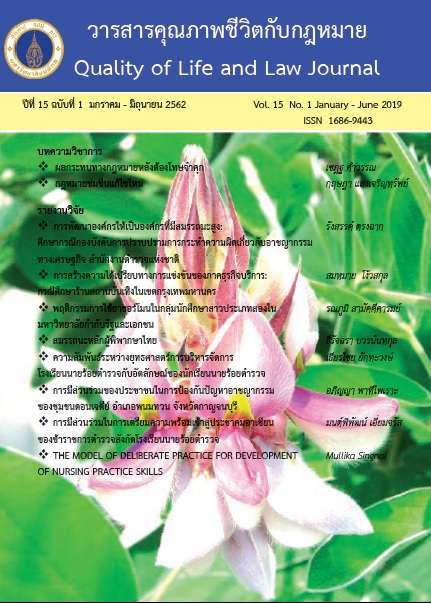CORE COMPETENCY OF THAI JUDGE
Main Article Content
Abstract
The objectives of this study were to assess the core competency degree of Thai judge and delineate factors affected on such core competency aspects. Three hundred and eighty eight judges who worked in all level judiciary (First instance, Appeal and Supreme Courts) were sampled. The data was collected by questionnaire and analysis through Descriptive statistics as Percentage, Mean, and Standard Deviation included inferential statistics as ANOVA. The objectives of this study were to assess the core competency degree of Thai judge and delineate factors affected on such core competency aspects. Three hundred and eighty eight judges who worked in all level judiciary (First instance, Appeal and Supreme Courts) were sampled. The data was collected by questionnaire and analysis through Descriptive statistics as Percentage, Mean, and Standard Deviation included inferential statistics as ANOVA. The results can be summarized as follows: 1. In terms of personal background, most of the participants were appeal judges male with aged more than 50 years, married, had a Master’s Degree and had worked in their organizations more than 21 years. They are currently taking care of the dependent for two persons. The income level ranged more than 1-200,000 Baht per month. Apart from this, as for the performance factors, they also expressed their reason to be the judge as love to be and faith in career and agreed with the cooperation organizational communication 2. As far as the core competency level viewpoint is concerned, most of the sample judge officers expressed at high level of opinion on all aspects. The Highest level was on Integrity. The subordinates were as Achievement Goal, Teamwork, Service mind, Expertise respectively. 3. Factors related with core competency degree of Thai judge depending on age, the affiliated judicial level, monthly income, and work time period as the judicial work, and communication aspects in the organization. Recommendations from this study are that there should be the various work innovative competitions, cooperation with other units for public services, to review the annual performance, and survey for satisfaction of the client, provide the judge team work activities path obviously and upgrades innovation to work process. Similarly, comparative studies that looked at other judicial units and special courts in other competency areas and in delineate the competency indicators including the qualitative approach would also be useful.
Article Details
- บทความหรือข้อคิดเห็นใดๆ ในวารสารคุณภาพชีวิตกับกฎหมายเป็
- กองบรรณาธิการไม่สงวนสิทธิ์
References
ขวัญดาว แจ่มแจ้ง เรขา อรัญวงศ์ และปาจรีย์ ผลประเสริฐ. (2556). กลยุทธ์การพัฒนาสมรรถนะด้านการวิจัยของอาจารย์มหาวิทยาลัยราชภัฏกลุ่มภาคเหนือตอนล่าง, วารสารศึกษาศาสตร์มหาวิทยาลัยนเรศวร, 15(2), หน้า 86-76.
ดาระกา ศิริสันติสัมฤทธิ์. (2552). การศึกษารูปแบบสมรรถนะ บุคลากรสายงานสนับสนุนวิชาการ ในสถาบันอุดมศึกษาภาครัฐ, รายงานวิจัย, (คณะครุศาสตร์อุตสาหกรรม : สถาบันเทคโนโลยีพระจอมเกล้าคุณทหารลาดกระบัง, 2552), หน้า ก-ค.
ปาริฉัตร อุทัยพันธ์, บุญศรี พรหมมาพันธุ์ ศริศักดิ์ สุนทรไชย และ คมศร วงษ์รักษา. (2552). การพัฒนารูปแบบการประเมินสมรรถนะที่พึงประสงค์ของนักศึกษาเทคนิคเภสัชกรรม วิทยาลัยการสาธารณสุขสิรินธร สังกัดสถาบันพระบรมราชชนก, วารสารวิจัย มข, (มหาวิทยาลัยขอนแก่น,), หน้า 883 – 889
พิสมัย พวงคำ. (2551).สมรรถนะของบุคลากรสายสนับสนุนวิชาการ มหาวิทยาลัยขอนแก่น.วิทยานิพนธ์ปริญญาศิลปศาสตร์มหาบัณฑิต
พิชญาภา ยืนยาว. (2552). รูปแบบการบริหารทรัพยากรบุคคลในสถาบันอุดมศึกษา, วิทยานิพนธ์ปรัชญาดุษฎีบัณฑิต, (บัณฑิตวิทยาลัย : มหาวิทยาลัยศิลปากร)
ทิพอนงค์ กุลเกต. (2560 ). การพัฒนาสรรถนะและตัวบ่งชี้สมรรถนะการจัดการเรียนการสอนวิชาชีพด้านธุรกิจค้าปลีก. วารสารศิลปากรศึกษาศาสตร์วิจัย, 9(1)
ไพรวัลย์ รัตนมา. (2560). แนวทางการพัฒนาประสิทธิภาพการให้บริการประชาชนของข้าราชการศาลยุติธรรม จังหวัดสุราษฎร์ธาน วารสารวิชาการ มหาวิทยาลัยราชภัฏพระนคร
ราชบัณฑิตยสถาน. (2558). พจนานุกรม ฉบับราชบัณฑิตยสถาน พ.ศ.2554 ฉบับพิมพ์ครั้งที่ 2. กรุงเทพมหานคร.
วิจารย์ พานิช. (2559). วิธีการพัฒนาสมรรถนะที่ดีกว่าการฝึกอบรม. เว็บไซต์ https://www.gotoknow.org/posts/498065. สืบค้นเมื่อ 23 มิถุนายน 2559.
ศันสนีย์ นิจพานิช และโชคชัย มงคลสินธุ์. (2551). การพัฒนารูปแบบการประเมินขีดสมรรถนะหลักบุคลากรสาธารณสุขจังหวัดกาฬสินธุ์, เวชสารโรงพยาบาลมหาราชนครราชสีมา, 32(1), หน้า 174.
สุกัญญา รัศมีธรรมโชติ. (2548). แนวทางการพัฒนาศักยภาพมนุษย์ด้วย Competency กรุงเทพฯ : ศิริวัฒนาอินเตอรืพริ้นติ้ง
สุกัญญา รัศมีธรรมโชติ. (2547). Competency : เครื่องมือการบริหารที่ปฏิเสธไม่ได้. Productivity. 9(53) : 20-25
สำนักงานคณะกรรมข้าราชการพลเรือน (2558). บุคลากรภาครัฐในระบบการบริหาร.ก.พ.
สืบวงศ์ กาฬวงศ์. (2554). ตัวแบบสมรรถนะผู้นาเชิงยุทธศาสตร์ของนายกองค์การบริหารส่วนตำบล, วิทยานิพนธ์รัฐประศาสนศาสตรดุษฎีบัณฑิต, คณะรัฐประศาสนศาสตร์: สถาบันบัณฑิตพัฒนบริหารศาสตร์
สมพงษ์ จิตระดับและคณะ. (2556). การพัฒนาสมรรถนะระบบที่ปรึกษาให้สภาเด็กและเยาวชนในประเทศไทย. รายงานการวิจัย, (สำนักงานสวัสดิภาพและพิทักษ์เด็ก เยาวชน ผูด้อยโอกาส และผู้สูงอายุ : กระทรวงการพัฒนาสังคมและความมั่นคงของมนุษย์, 2556), หน้า ก.
อภิษฎาข์ ศรีเครือดง. (2556). รูปแบบการพัฒนาภาวะผู้นำที่พึงประสงค์ตามแนวพุทธของผู้บริหารสตรีในมหาวิทยาลัยของรัฐ, วิทยานิพนธ์พุทธศาสตรดุษฎีบัณฑิต, บัณฑิตวิทยาลัย: มหาวิทยาลัยมหาจุฬาลงกรณมหาวิทยาลัย
อเนก เทียนบูชา. (2552). การพัฒนาสมรรถนะหลักเพื่อเตรียมคนเข้าสู่งาน. ดุษฎีนิพนธ์ (เทคโนโลยีสารสนเทศและการสื่อสารเพื่อการศึกษา). กรุงเทพฯ : มหาวิทยาลัยเทคโนโลยี พระจอมเกล้าพระนครเหนือ.
เอกอนงค์ คงประสม. (2560). สมรรถนะหลักของบุคลากรสายสนับสนุนเพื่อส่งเสริมยุทธศาสตร์มหาวิทยาลัยศิลปากรสู่การเป็นองค์กรแห่งการเรียนรู้. KKU Res J (GS), 11(2)
The Teaching Competency and Indicators for Learner Profession. (2557). วารสารบัณฑิตศึกษา มหาวิทยาลัยราชภัฏวไลยอลงกรณ์ ในพระบรมราชูปถัมภ์, 8(3)
Bonjour, E., & Micaelli, J. P. (2010). Design core competence diagnosis: a case from the automotive industry. Engineering Management, IEEE Transactions, 57(2), 323-337.
Hellriegel, Don., Jackson Susan E., Slocum, John W.(2001) Management: A Competency-Based Approach, 9th ed. United State of America:Thompson, South-Western EducationalPublishing.
Hughes, R. (2004). A competency framework for public health nutrition workforce development. Australian Public Health Nutrition Academic Collaboration. Retrieved August 12, 2008, from http://www. aphnac.com/media/files/252.pdf
Prahalad, C.K. and Hamel, G. (1990). The core competence of the corporation Archived 2014-07-14 at the Wayback Machine, Harvard Business Review, 68(3); pp. 79–91.
Schilling, M. A. (2013). Strategic management of technological innovation, International Edition, McGraw-Hill Education.
Yang, C. (2015). The integrated model of core competence and core capability. Total Quality Management. 26: 173–189.


